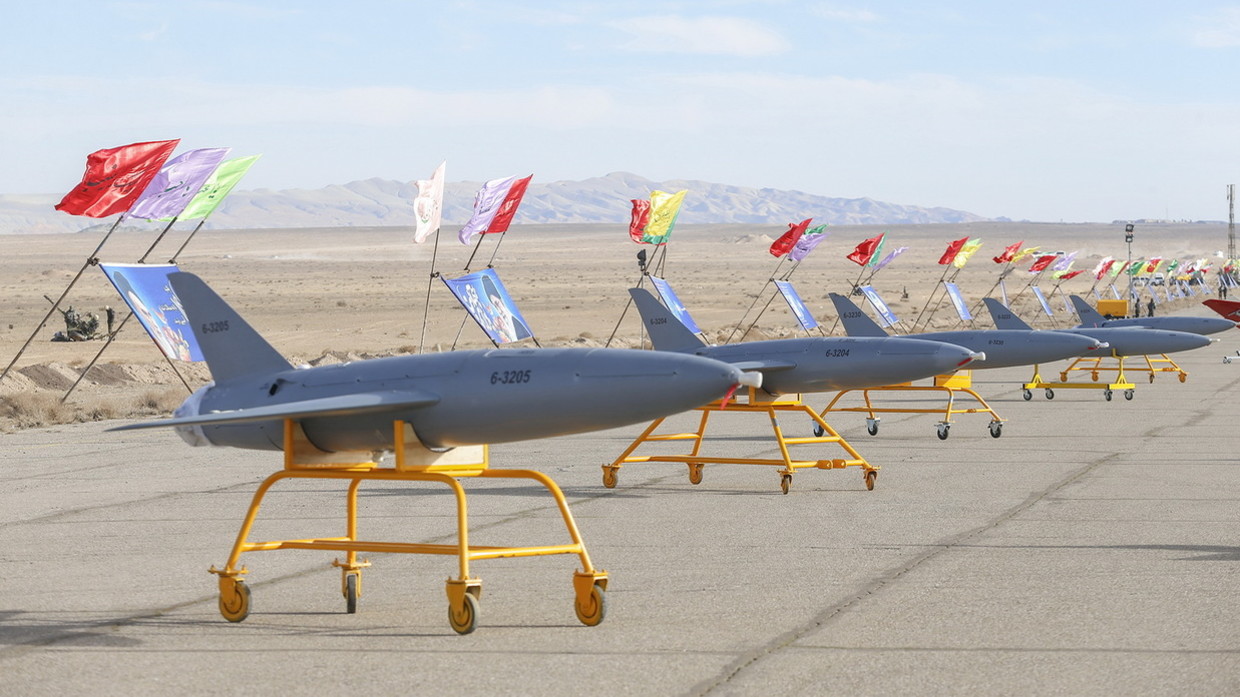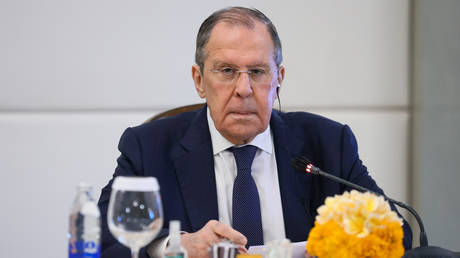Last Monday, US National Security Advisor Jake Sullivan claimed that Iran is preparing to send "several hundred" UAVs to Russia, to be used in Moscow’s military operation in Ukraine. Iran outright rejected the claim and Russia has made no comments on the statement.
Meanwhile, Tehran and Moscow announced that President Vladimir Putin will be visiting the Iranian capital next week to hold talks with President Ebrahim Raisi.
Here, RT looks into Iranian drones to see whether they could be of use to Russia in the course of the special operation in Ukraine. We will also explain why the US is alarmed by the prospect and how this development could affect the likelihood of the sanctions on Iran being lifted.
‘According to our intel…’
"Our information indicates that the Iranian government is preparing to provide Russia with up to several hundred UAVs, including weapons-capable UAVs on an expedited timeline," Sullivan asserted.
He was talking to reporters about Ukraine – therefore, while it wasn’t explicitly stated, one can assume that the US now expects Iranian drones to see action in Eastern Europe.
“It’s unclear whether Iran has delivered any of these UAVs to Russia already,” Sullivan said, adding that the country will start training Russian forces to use the drones as early as this month.
“This is just one example of how Russia is looking to countries like Iran for capabilities that... have been used before we got the ceasefire in place in Yemen to attack Saudi Arabia,” Sullivan explained.
It was early Tuesday morning in Moscow when the briefing was broadcast in the US, but Russian officials are yet to make any comments about the subject. There was, however, other news from the Kremlin, as presidential spokesman Dmitry Peskov announced that Vladimir Putin would visit Tehran the following week, on July 19.
The agenda and details of the bilateral meeting between Putin and Iranian President Ebrahim Raisi have not been disclosed.
“There will be a meeting of the heads of the guarantor states of the Astana process, which, as you know, is the process to facilitate a resolution to the Syrian crisis. There will, indeed, be a meeting between Putin, Raisi and Erdogan. In addition to the trilateral meeting, bilateral talks will also take place,” Peskov said.
As for Tehran, it flatly denied it has any plans to cooperate with Russia by supplying it with UAVs. When asked about the claim by a media representative, Iranian Foreign Ministry spokesman Nasser Kanaani said:
“Cooperation between Iran and Russia in certain advanced technologies dates back to before the Ukraine war, and there have been no major developments in the area in the recent past.”
What we know about Iranian UAVs
Washington had been wary of Iran’s drone program even before Russia launched its military operation in Ukraine. Last November, the US introduced sanctions against Iranian private companies that were supposedly involved in the production of combat and reconnaissance UAVs.
According to the Americans, these companies claimed to be engaged in “private research” while covertly providing critical support to the UAV development of Iran’s Islamic Revolutionary Guard Corps and conducting international transactions in the interests of the Iranian government. The latter, in turn, supplied drones to its allies – including groups that the US recognizes as terrorist organizations.
Notably, even back then, the US Treasury Department insisted that Iranian UAVs “threaten international peace and stability.”
Denis Fedutinov, editor-in-chief of the magazine Drone Aviation, told RT that Iranian drones are actually very much worth looking into – the country has been designing them since the 1980s.
“Currently, Iran has several dozen drone systems, from miniature drones to medium-altitude long-endurance models,” he said.
Some Iranian UAVs were inspired by the US designs. For example, the Qods Yasir is based on the Boeing Insitu ScanEagle intercepted by the Iranians in 2012, while the Shahed 171 Simorgh and Saegheh-2 have a lot in common with the RQ-170 Sentinel that violated Iranian airspace in 2011.
Visually similar to the US MQ-1 Predator, the Shahed 129 attack drones are of particular interest, as they have played an active role in the civil war in Syria since 2014.
“Iran isn’t too keen on sharing information on its drones, revealing only what’s beneficial to it. But doubtless, one of its advantages is its vast experience in UAV development,” Denis Fedutinov noted.
Nevertheless, Iranian technology cannot hold a candle to its Turkish competition.
“Turkish designers partner with the leading suppliers of various drone subsystems in the market, which makes it easier for them to develop more sophisticated equipment.”
Why does Russia need Iranian drones?
Viktor Litovkin, a retired colonel and military commentator for TASS, told RT that “all drones are essentially the same.”
“The only difference is their role, their loadout and their flight time. Iran doesn’t have any outstanding drones, but nor does anybody else. All drones are essentially the same,” he explained.
Moscow has also been developing its own UAVs for quite some time. Russian Vice Prime Minister Yuri Borisov, who is in charge of supervision of the defense industry, said last month that Russia “has access to almost all types of unmanned military aerial systems, including reconnaissance, attack, tactical, operational and operational-tactical models.”
At the same time, he doesn’t deny that Russia “should’ve recognized the benefits of drones much earlier.”
Answering RT’s question about the “shortage of drones,” Borisov promised to “ramp up production,” adding, “it takes time.”
This may be interpreted as a sign that Russia considers Iranian drones to be a temporary solution until Russian drones are put into service.
Fedutinov argues that if a deal were to be signed, Moscow would be interested mainly in heavy recon and attack UAV systems.
“Had they been available to the Russian Army, I don’t see any obstacles to fielding such systems [in Ukraine]. And as far as civilian casualties or friendly fire are concerned, drones carry high-precision weapon systems that minimize those risks,” Fedutinov said.
Litovkin expressed doubt that Iranian drones would see any use in Ukraine.
“No type of weapon could change the course of the war. Well, nuclear weapons could, but escalating the conflict in Ukraine to a nuclear war is out of the question. Drones are not weapons per se, they are combat platforms,” he said.
Will Iran be able to cover Russia’s UAV demand?
“It sounds like Iranian companies have been able to launch mass production of drones. And we can even say that they have begun to sell their UAV systems to certain customers,” Fedutinov said when asked if Iran was capable of exporting drones.
Litovkin agrees. According to him, “Iran has manufactured a significant number of drones that are just being stored at warehouses right now.”
“Iran is not engaged in any wars, so it doesn’t need all those drones, while Russia could use them in its Ukraine campaign. It is no wonder then that we could buy different types of UAVs from Iran,” the military expert believes.
Vladimir Sazhin, from the Institute of Oriental Studies at the Russian Academy of Sciences and an expert on Iran, disagrees: “Iran has many adversaries in the region, including Israel, the Gulf countries, Jordan and Egypt. There have even been proposals to establish a ‘Middle Eastern NATO.’ All these developments keep pressure on Iran, so I don’t think it will jeopardize its defense capabilities by giving its drones to some other country.”
Sazhin also has doubts about Teheran’s ability to mass produce and export UAVs, “Iran supplies drones to its ‘allies’ – mostly, Yemen’s Houthis, and we can hardly count them in the hundreds, dozens would be a more realistic estimate, and we don’t even know the type. Besides military drones, Iran also manufactures simple models, almost like toys. I don’t think Iran is capable of increasing the scale of production in such limited time. The systems that are manufactured in Iran right now can hardly be exported.”
What else stands in the way?
“I don’t think there was any kind of plan to sell drones to Russia before February 24. Maybe there were some discussions after that, but I doubt anything will actually happen,” Sazhin says.
He believes that political considerations are also involved, “Iran is neutral on the conflict between Russia and Ukraine. Its unwavering position is that a ceasefire should be reached as soon as possible. I don’t think Iran plans to take either side, by supporting Russia and opposing the West.”
He also said that Tehran is heavily invested in the Vienna talks on resuming the Iranian nuclear deal, which was basically abolished by the Donald Trump administration.
“Iran wants to see this deal come through, because it wants the Western sanctions to be lifted. The EU, Japan and other countries support Teheran in its agenda. They can’t wait for the sanctions to be eased, because that will give them instant access to the Iranian economy, which has been in dire straits. Tehran really needs external investments in all industries. And technology. Obviously, Russia can’t help it with either, while the EU and Japan can,” Sazhin explained.
The expert also notes that by supplying Russia with drones Iran would face more pressure from the West, which would jeopardize its future partnerships with countries that could provide investment and technology.
“That is not the kind of risk Iran is ready to take, this configuration doesn’t benefit it,” Sazhin added.
The expert says that a behind-the-scenes deal between Moscow and Teheran is also impossible.
“Today, a deal like that would remain a secret for only a few hours. Even if Iran secretly supplies Russia with its drones, they will be discovered in the combat zone. This would put Iran in an even more difficult situation,” according to Sazhin.


